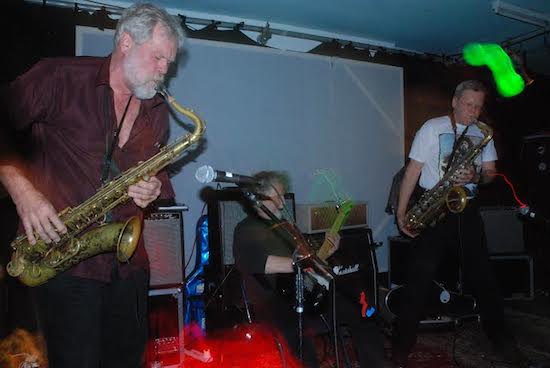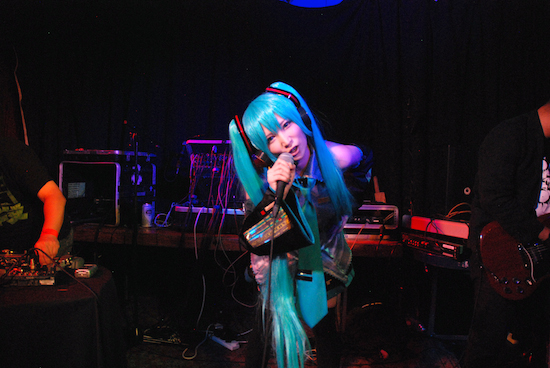Situated on the cusp of Newcastle’s Ouseburn Valley, a former industrial base turned arts quarter (of sorts), the Star and Shadow is a special place. A former television warehouse, this volunteer run venue and cinema has been host to Lee Etherington’s Tusk Festival for the past four years, one of the finest – and friendliest – expressions of underground and experimental music culture in these islands. With the building’s lease up, this was the final Tusk in the Star and Shadow’s present location. But what a way to go out, with perhaps the festival’s strongest and most varied line-up yet, ranging from Japanese noise legends and Georgian bards to Egyptian synth wizards and techno outliers. As always, the North East’s DIY music scene was strongly represented – shout outs to Girl Sweat’s demented DIY pop, Charles Dexter Ward’s kosmiche guitar reveries and Smut’s white-light blare – while the adjacent Blank Studios provided gallery space for excellent Jad Fair and Andrew Chalk exhibitions and solo sets from Hijokaidan’s incredible vocalist Junko.
Asiq Nargile is a revelation
Introduced by Stefan Williamson Fa, whose marvelous Sayat Nova Project has brought the music and culture of the Caucasus to wider attention, Georgian bard Asiq Nargile is a revelation. Hailing from the ethnic Azeri region of Borcali, Nargile is a carrier of the asiq tradition, performing songs based on epic poetry with saz accompaniment. Her voice is incredibly powerful, an arresting alto which soars over her improvised saz parts. A virtuoso of the instrument, she combines spidery modal runs with rippling zither-like chords, even indulging in the odd Dick Dale style dive-bomb run. Amazing.
As the Quietus’s John Doran has already reviewed EEK and Islam Chipsy’s London debut, I won’t say too much about the King Of Nile Delta synth’s Tusk set. In the flesh, their music sounds less like demented Gameboy gabber and more like the Egyptian street party music it is, with Chipsy firing pitch-bend melodies and Sun Ra-style tone clusters over Khaled Mando and Islam Tata’s whip-crack roto-tom rhythms. A deliriously exciting set which whips the audience into a frenzy.
Far more traditional, but just as ecstatic, were Irshad Ali Qawwali Party, a quartet of young qawwali masters from Rajasthan. In their hands, this ancient Sufi tradition sounds gloriously alive. Over flute, shimmering harmonium and insanely complex tabla rhythms, Irshad Ali and his brothers’ voices reach to the heavens in a celebration of the divine. To hear such music live is a rare privilege and a joy.
Borbetomagus and Hijokaidan are perhaps the greatest noise bands on the planet
"We are trained fucking musicians," notes Borbetomagus guitarist Donald Miller during the veteran New York noise trio’s Sunday lunchtime talk with David Keenan. "We know exactly what we’re fucking doing". "Even when we don’t!" chips in saxophonist Don Dietrich. Their festival closing set later that evening leaves you in no doubt of their utter mastery of the form.
In the broadest sense, Borbetomagus are a free improv group, but there’s none of the fussiness of clenched-bum improv here; these motherfuckers wanna kick out the jams, using their profound understanding of their instruments’ sonic properties to march towards freedom. Dietrich and fellow saxophonist Jim Sauter run their horns through guitar amps and pedals, with vocal mics placed inside the bells. Combined with Miller’s fuzz-toned slide guitar, it creates a howling vortex, sirens shrieking over a spuming mass. Yet even in the eye of the storm, there’s a real delicacy to their noise-making, not least in Miller’s woozy Telecaster glisses and Sauter and Dietrich’s intimate locked horn technique, where the bells of their saxophones are placed together, creating one resonating chamber. This teeming, blissful racket is a full body experience, an acid jacuzzi for the polymorphously perverse.
For the encore, Borbetomagus are joined by their old friends and collaborators Hijokaidan, whose own Saturday headline set was a righteous blast of ravaged free-rock. For this, everyone goes baws-oot, with Miller and Jojo Hiroshige crossing axes, the saxophonists fending off Toshiji Mikawa’s digital blats with guttaral volleys, and the great Junko peeling the paint from the walls with her inhuman screams. Sheer joyous miasma.

Japanese pop + horrible noise = joy!
Hatsune Kaidan is what happens when Japan’s favourite virtual pop star meets its greatest noise band. A singing synthesiser application with a human persona, Hatsune Miku is a phenomenon in Japan, appearing in concert as a hologram. In Hijokaidan’s real-world take, Le Chat performs as her avatar, resplendent in turquoise pigtails and plastic chipboard dress. Musically, it’s pretty much what you’d expect, with Jojo Hiroshige and Toshiji Mikawa lobbing digital sound grenades and gobbets of guitar noise at Le Chat’s live vocals and gloriously synthetic backing tracks. There’s no communication or dialogue as such, but it would be wrong to think of Hiroshige and Mikawa as avant-garde bullies arrogantly obliterating pop with noise. If anything, they’re celebrating Japanese pop in all its neon glory, intensifying the sugar rush with an adrenalising jolt of chaos. Jojo’s neck throttling guitar squalls are an oddly tender counterpoint to the relentless trance synths, while Mikawa has a ball scratching wildly on a CD DJ over the euphoric beats. Le Chat sweetly but firmly holds her own amid the maelstrom, making for a giddy and oddly moving experience.
Tabletop sets can still surprise
Watching someone lean over a tabletop spread of boxes, pedals and gadgets might not be the most visually arresting of experiences, but Tusk has a knack of booking acts who make the most of such set ups. On the Friday, Thought Broadcast, aka San Francisco’s Ravi Binning, impresses with his real time manipulation of grimy electronic signals into dislocated beats. Mangling his voice through a DIY circuit board synth, Binning barks in inscrutable cyborg tongues over a spacious mix of lo-fi minimal techno and early industrial. Jahiliyya Fields is a highlight of the Saturday, layering bowed electronic groans and modular synth bleeps over mutant techno fragments. It’s genuinely interesting to watch how he builds it all up, as he fiddles with patch cables, tweaks delay pedals and punches at sample pads.
Sunday evening, meanwhile, offers the one-two punch of Australian duo Half High and Norbert Moslang. Looking like chic 1970s radicals, Half High’s Matthew P. Hopkins (Beatnik goatee and cap) and Lucy Phelan (sharp bob and beret) coax uneasy electronic tones from their hardware, mapping out an uncanny landscape in which eerie science fiction atmospherics are strafed by rising synth tones and weirdly funky techno handclaps. One of the discoveries of the weekend, Half High plot an often inspired path through underground noise and electronic strategies. Moslang, formerly of Swiss duo Voice Crack, follows with a masterclass in euphoric noise, unleashing vast silver waves over a whomping four-to-the-floor beat. Too escstatic to be industrial music, Moslang’s set hardwires the heaviest kosmische to the hardest Detroit techno.
I’d rather Jeck, than Fleetwood Mac
Excuse the atrocious pun on The Reynold Girls’ cheeky pop favourite, but it seems apt given Phillip Jeck’s turntable, laptop and sampler based reconstruction of Fleetwood Mac’s Tusk. Yes, he went there, but happily, what could have been a glib novelty set yields sublime results. A watery piano ushers in the unmistakable cocaine and honey tones of Stevie Nicks: "Beautiful child…"
Jeck works over the phrase, repeating it, modulating it and layering it so it goes in and out of phase. Gradually, he introduces other parts of the song, their delayed entry deepening the ache. As a huge fan of Tusk, I’m fascinated and moved by Jeck’s artful and sensitive bricolage. The echoes and vinyl crackles intensify the torpid emotions beneath the music’s luminous textures, highlighting Nicks’ oft-overlooked brilliance as a lyricist: "Your eyes say yes, but you don’t say yes." As the set progresses, Jeck weaves in phantasmal vocals and Fender Rhodes from Christine McVie’s ‘Brown Eyes’ spiral into the ether, and a spindly guitar is isolated from Nicks’ gorgeous ‘Storms’.
Laura Cannell is the Roland Rahsaan Kirk of neo-medieval music
The noon hangover slot has produced some of the greatest Tusk moments, not least Pelt and Part Wild Horses Main on Both Sides’ gamelan improvisation in 2012. This year gave us Elodie’s gorgeous autumnal drones, all e-bow guitar, clarinet and turning leaves, and an outstanding set of neo-medieval music for fiddle and recorder from Norfolk based Laura Cannell. A collaborator with This Heat drummer Charles Hayward and Ralph ‘Bass Clef’ Cumbers, among others, Cannell is no academic revivalist, finding her individual voice through an open-minded compositional approach and innovative instrumental techniques. She often plays her fiddle with a deconstructed bow, placing the hair over the strings to create a droning chordal accompaniment to her beautiful edge-of-the-world melodies. Recalling the jazz multi-instrumentalist Roland Rahsaan Kirk, whose signature technique was the playing of several horns at once, Cannell reconstructs the music of 12th century mystic Hildegard Von Bingen on double recorders, her left hand weaving an alto counterpoint around the right hand melody. A magical set which deftly captures the ancient-modern spirit of Tusk.
<div class="fb-comments" data-href="http://thequietus.com/articles/16492-festival-report-tusk” data-width="550">


